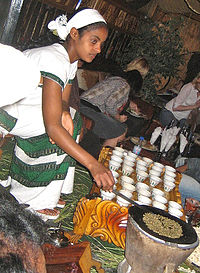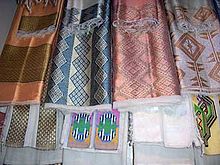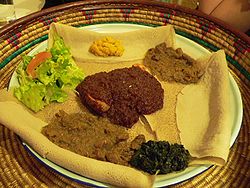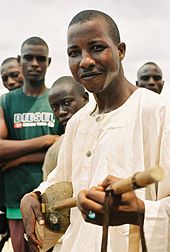- Culture of Africa
-
 An Ethiopian woman preparing Ethiopian coffee at a traditional ceremony. She roasts, crushes and brews the coffee on the spot.
An Ethiopian woman preparing Ethiopian coffee at a traditional ceremony. She roasts, crushes and brews the coffee on the spot.
The culture(s) of Africa encompasses and includes all cultures within the continent of Africa. There is a political or racial split between North Africa, and Sub-Saharan Africa, which is in turn divided into a great number of ethnic cultures.[1] [2][3][4]African cultures are diverse and varied and not static, and like most of the world have been impacted upon by both internal and external forces. [5]
Contents
Historical Overview
Africa’s cultural regeneration has also been an integral aspect of post-independence nation-building on the continent, with a recognition of the need to harness the cultural resources of Africa to enrich the process of education, requiring the creation of an enabling environment in a number of ways. In recent times, the call for a much greater emphasis on the cultural dimension in all aspects of development has become increasingly vocal.[6] During colonialism in Africa, Europeans possessed attitudes of superiority and a sense of mission. The French were able to accept an African as French, if they gave up their African culture and adopted French ways. Knowledge of Portuguese language and culture and abandonment of traditional ways defined one as civilized.[7]Kenyan social commentator Mwiti Mugambi pragmatically argues that the future of Africa can only be forged from accepting and mending the sociocultural present. For Mugambi, colonial cultural hangovers, pervasive Western cultural inundation, and aid-giving arm-twisting donors are, he argues, here to stay and no amount of looking into Africa's past will make them go away. However Karenga states that
Our culture provides us with an ethos we must honor in both thought and practice. By ethos, we mean a people's self-understanding as well as its self-presentation in the world through its thought and practice in the other six areas of culture. It is above all a cultural challenge. For culture is here defined as the totality of thought and practice by which a people creates itself, celebrates, sustains and develops itself and introduces itself to history and humanity
— Maulana Karenga , African Culture and the Ongoing Quest for Excellence
People
Africa is home to innumerable tribes, ethnic and social groups, some representing very large populations consisting of millions of people, others are smaller groups of a few thousand. Some countries have over 20 different ethnic groups, and also are greatly diverse in beliefs.
African Art and Crafts
Africa has a rich tradition of arts and crafts. African arts and crafts find expression in a variety of woodcarvings, brass and leather art works. African arts and crafts also include sculpture, paintings, pottery, ceremonial and religious headgear and dress. Maulana Karenga states that in African art, the object was not as important as the soul force behind the creation of the object. He also states that All art must be revolutionary and in being revolutionary it must be collective, committing, and functional, this is echoed by Shahadah who states "in Africa all art is socially functional."[8][9][5]
African culture has always placed emphasis on personal appearance and jewelry has remained an important personal accessory. Many pieces of such jewellery are made of cowry shells and similar materials. Similarly, masks are made with elaborate designs and are important part of African culture. Masks are used in various ceremonies depicting ancestors and spirits, mythological characters and deities.
In most of traditional art and craft of Africa, certain themes significant to African culture recur, including a couple, a woman with a child, a male with a weapon or animal, and an outsider or a stranger. Couples may represent ancestors, community founder, married couple or twins. The couple theme rarely exhibit intimacy of men and women. The mother with the child or children reveals intense desire of the African women to have children. The theme is also representative of mother mars and the people as her children. The man with the weapon or animal theme symbolizes honor and power. A stranger may be from some other tribe or someone from a different country, and more distorted portrayal of the stranger indicates proportionately greater gap from the stranger.
Folklore and Religion
Like all human cultures, African folklore and religion represents a variety of social facets of African culture [1]. Like almost all civilizations and cultures, flood myths have been circulating in different parts of Africa. Culture and religion share space and are deeply intertwined in African cultures. In Ethiopia Christianity and Islam form the core aspects of Ethiopian culture and inform dietary customs as well as rituals and rites.[5][10] According to a Pygmy myth, Chameleon hearing a strange noise in a tree cut open its trunk and water came out in a great flood that spread all over the land.
Clothing
Women's traditional clothes in Ethiopia are made from cloth called shemma and used to make habesha qemis: it is basically cotton cloth, about 90 cm wide, woven in long strips which are then sewn together. Sometimes shiny threads are woven into the fabric for an elegant effect.
Men wear pants and a knee-length shirt with a white collar, and perhaps a sweater. Men often wear knee-high socks, while women might not wear socks at all. Men as well as women wear shawls, the neTela. In West Africa much of the local dress is influenced by Islamic traditions. [5] Zulus wear a variety of attire, both traditional for ceremonial or culturally celebratory occasions, and modern westernised clothing for everyday use.
Traditional male clothing is usually light, consisting of a two-part apron (similar to a loincloth) used to cover the genitals and buttocks. The front piece is called the umutsha (pronounced [umuːtʃa]), and is usually made of springbok or other animal hide twisted into different bands which cover the genitals. The rear piece, called the ibheshu [ibeːʃu], is made of a single piece of springbok or cattle hide, and its length is usually used as an indicator of age and social position; longer amabheshu (plural of ibheshu) are worn by older men. Married men will usually also wear a headband, called the umqhele [umǃʰɛle], which is usually also made of springbok hide, or leopard hide by men of higher social status, such as chiefs. Zulu men will also wear cow tails as bracelets and anklets called imishokobezi [imiʃoɠoɓɛːzi] during ceremonies and rituals, such as weddings or dances.
Cuisine
Africa is a huge continent and the food and drink of Africa reflect local influences, as also glimpses of colonial food traditions, including use of food products like peppers, peanuts and maize introduced by the colonizers. The African cuisine is a combination of traditional fruits and vegetables, milk and meat products. The African village diet is often milk, curds and whey. Exotic game and fish are gathered from Africa's vast area.
Traditional African cuisine in most of Africa is characterized by use of starch as a focus, accompanied by stew containing meat or vegetables, or both. Cassava and yams are the main root vegetables. Africans also use steamed greens with hot spices. Dishes of steamed or boiled green vegetables, peas, beans and cereals, starchy cassava, yams and sweet potatoes are widely consumed. In each African locality, there are numerous wild fruits and vegetables which are used as food. Watermelon, banana and plantain are some of the more familiar fruits.[citation needed]
Differences are also noticeable in eating and drinking habits across the continent of Africa. Thus, North Africa, along the Mediterranean from Morocco to Egypt has different food habits than Saharan Africans who consume subsistence diet. Nigeria and coastal parts of West Africa love chilies in food. The non-Muslim population of Africa uses alcoholic beverages, which go well with most African cuisine. The most familiar alcoholic drink in the interior Africa is the Ethiopian honey wine called Tej.
Cooking techniques of West Africa often combine fish and meat, including dried fish. The cuisine of South Africa and neighboring countries have largely become polyglot cuisines, having influences of several immigrants which include Indians who brought lentil soups (dals) and curries, Malays who came with their curries with spices, and Europeans with "mixed grills" that now include African game meats. Traditionally, East African cuisine is distinctive in the sense that meat products are generally absent. Cattle, sheep and goats were regarded as a form of currency, and are not generally consumed as food. Arabic influences are also reflected in East African cuisine – rice cooked with spices in style, use of cloves, cinnamons, several other spices, and juice.
Ethiopians lay claim to first regular cultivation of coffee, and they have a sort of coffee ceremony, like Japanese tea ceremony. From Ethiopia, coffee spread to Yemen, from there it spread to Arabia, and from there to the rest of the World.
African Music
Traditional Sub-Saharan African music is as diverse as the region's various populations. The common perception of Sub-Saharan African music is that it is rhythmic music centered around the drums. It is partially true. A large part of Sub-Saharan music, mainly among Niger–Congo linguistic groups is rhythmic and centered around the drum. Sub-Saharan music is polyrhythmic, usually consisting of multiple rhythms in one composition. Dance involves moving multiple body parts. These aspect of Sub-Saharan music has been transferred to the new world by enslaved Sub-Saharan Africans and can be seen in its influence on music forms as Samba, Jazz, Rhythm and Blues, Rock & Roll, Salsa, and Rap music.[11]
But Sub-Saharan music involves a lot of music with strings, horns, and very little poly-rhythms. Music from the eastern sahel and along the nile, among the Nilo-Saharan, made extensive use of strings and horns in ancient times. Among the Afro-Asiatics, we see extensive use of string instruments. Dancing involve swaying body movements and footwork. Among the Khoisans extensive use of string instruments with emphasis on footwork.[12]
Modern Sub-Saharan African music has been influence by music from the New World (Jazz, Salsa, Rhythm and Blues etc.) vice-versa being influenced by enslaved Sub-Saharan Africans. Popular styles are Mbalax in Senegal and Gambia, Highlife in Ghana, Zoblazo in Ivory Coast, Makossa in Cameroon, Soukous in the Democratic Republic of Congo, Kizomba in Angola, and Mbaqanga in South Africa. New World styles like Salsa, R&B/Rap, Reggae, and Zouk also have widespread popularity.
Languages
Main article: African languagesThe main ethno-linguistic divisions are Afro-Asiatic (North Africa, Chad, Horn of Africa), Niger–Congo (mostly Bantu) in most of Sub-Saharan Africa, Nilo-Saharan in parts of the Sahara and the Sahel and parts of Eastern Africa, and Khoisan (indigenous minorities of Southern Africa.[13] The continent of Africa speaks hundreds of languages, and if dialects spoken by various ethnic groups are also included, the number is much higher. These languages and dialects do not have the same importance: some are spoken by only few hundred persons, others are spoken by millions. Among the most prominent languages spoken are Arabic, Swahili and Hausa. Very few countries of Africa use any single language and for this reason several official languages coexist, African and European. Some Africans speak various languages such as English, Spanish, French, and Dutch.
See also
References
- ^ Classification of Sudan in both North and Sub-Africa
- ^ Khair El-Din Haseeb et al., The Future of the Arab Nation: Challenges and Options, 1 edition (Routledge: 1991), p.54
- ^ Halim Barakat, The Arab World: Society, Culture, and State, (University of California Press: 1993), p.80
- ^ Tajudeen Abdul Raheem, ed., Pan Africanism: Politics, Economy and Social Change in the Twenty First Century, Pluto Press, London, 1996.
- ^ a b c d "African Culture Complex". http://www.africanholocaust.net/africanculture.html. Retrieved 2011-10-04.
- ^ http://ocpa.irmo.hr/resources/docs/COMEDAFII_Unesco_EdCultRole-en.pdf “EDUCATION AND CULTURE IN AFRICA’S QUEST FOR DEVELOPMENT”
- ^ Khapoya, op. cit. p. 126f
- ^ http://www.africawithin.com/karenga/on_black_art.htm Karenga on Black Art
- ^ "Pambazuka Online". Pambazuka. http://www.pambazuka.org/en/category/features/42249.
- ^ Richard Pankhurst, 1997, `History of the Ethiopian Borderlands: Essays in Regional History, Lawrenceville, New Jersey.
- ^ Bowden, Rob(2007). Africa South of the Sahara. Coughlan Publishing: p. 40, ISBN 1-4034-9910-1.
- ^ Christopher Ehret, (2002). The Civilizations of Africa. Charlottesville: University of Virginia, p. 103, ISBN 0-8139-2085-X.
- ^ Greenberg, Joseph H. (1966). The Languages of Africa (2nd ed.). Bloomington: Indiana University.
External Links
Culture of Africa Sovereign
states- Algeria
- Angola
- Benin
- Botswana
- Burkina Faso
- Burundi
- Cameroon
- Cape Verde
- Central African Republic
- Chad
- Comoros
- Democratic Republic of the Congo
- Republic of the Congo
- Côte d'Ivoire (Ivory Coast)
- Djibouti
- Egypt
- Equatorial Guinea
- Eritrea
- Ethiopia
- Gabon
- The Gambia
- Ghana
- Guinea
- Guinea-Bissau
- Kenya
- Lesotho
- Liberia
- Libya
- Madagascar
- Malawi
- Mali
- Mauritania
- Mauritius
- Morocco
- Mozambique
- Namibia
- Niger
- Nigeria
- Rwanda
- São Tomé and Príncipe
- Senegal
- Seychelles
- Sierra Leone
- Somalia
- South Africa
- South Sudan
- Sudan
- Swaziland
- Tanzania
- Togo
- Tunisia
- Uganda
- Zambia
- Zimbabwe
States with limited
recognition- Sahrawi Arab Democratic Republic
- Somaliland
Dependencies and
other territories- Canary Islands / Ceuta / Melilla / Plazas de soberanía (Spain)
- Madeira (Portugal)
- Mayotte / Réunion (France)
- Saint Helena / Ascension Island / Tristan da Cunha (United Kingdom)
- Western Sahara
Africa topics Culture Architecture · Art · Cinema (Films · Film festivals) · Cuisine · Etiquette · Languages · Literature (Writers by country) · Music (Musicians) · Religion · World Heritage SitesDemographics People · Countries by population density · HIV/AIDS · Urbanization (Cities · Largest metropolitan areas) · EmigrationEconomy Countries by GDP (nominal) · Countries by HDI · Central banks and currencies · Education · Internet · Natural resources · Poverty · Renewable energy · Stock exchangesGeography History Politics African Union · Elections · Heads of government · Heads of state · International organisations (under construcion) · Pan-African Parliament
· Political parties · Human rights · Pan-Africanism · United States of AfricaSociety Sport Years 2004 in Africa · 2005 in Africa · 2006 in Africa · 2007 in Africa · 2008 in Africa · 2009 in Africa · 2010 in Africa · 2011 in Africa · 2012 in AfricaCategories:- African culture
Wikimedia Foundation. 2010.




